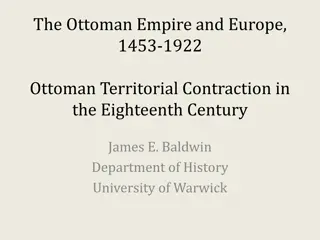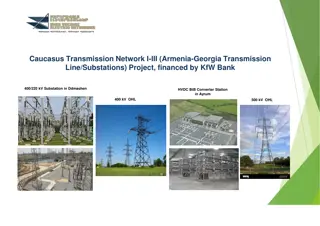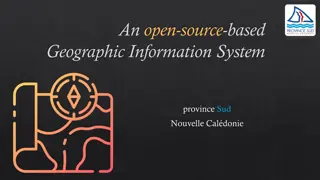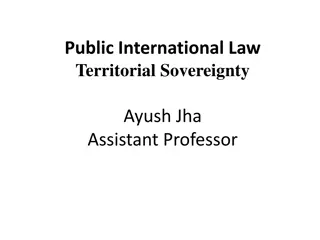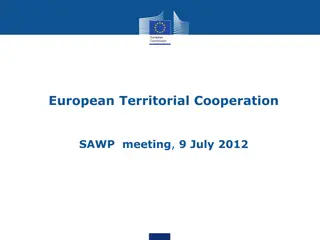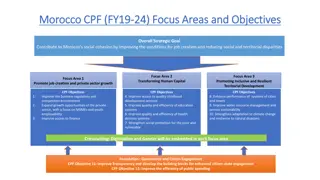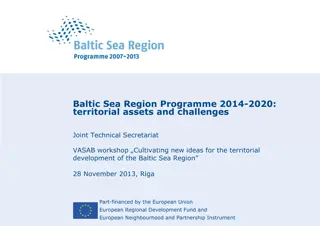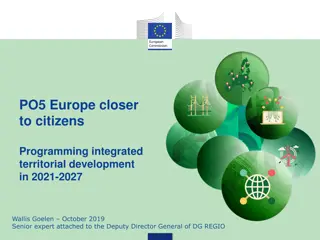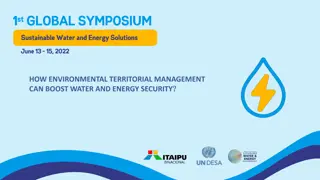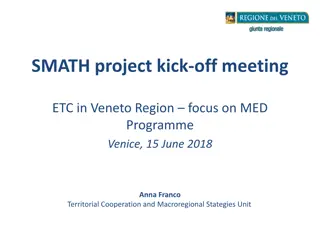Understanding CLLD in Territorial Development - A Comprehensive Overview
CLLD, a local development approach, focuses on sub-regional territories through public-private partnerships. It emphasizes bottom-up strategies, joint funding, and Lead Fund tools for managing locally funded strategies. The selection criteria for Local Development Strategies (LDS) and the content of LDS are crucial aspects in CLLD implementation, ensuring effective planning, targeting development needs, and achieving measurable results.
Download Presentation

Please find below an Image/Link to download the presentation.
The content on the website is provided AS IS for your information and personal use only. It may not be sold, licensed, or shared on other websites without obtaining consent from the author. Download presentation by click this link. If you encounter any issues during the download, it is possible that the publisher has removed the file from their server.
E N D
Presentation Transcript
Territorial Development SAWP Meeting, 3 July 2012 Peter Berkowitz, Head of Unit DG REGIO C.1 1
CLLD The LEADER Acquis Significant experience to build on: LEADER (EAFRD), Axis 4 (EFF), Urban Community Initiative (ERDF) and EQUAL (ESF) Bottom-up approach: implemented by local communities through public-private partnerships Focused on specific sub-regional territories, which can be urban, rural, fisheries dependent, cross-border or a mix of several Carried out through integrated and multi-sectoral local development strategies 2
CLLD Approach This local development approach is obligatory for EAFRD and optional for ERDF, ESF and EMFF There are also possibilities to carry out other forms of local development under ERDF, ESF and EAFRD, based on experience of MSs 3
CLLD - Local Development Strategies (LDS) Selection criteria for LDS are defined by MS Three options for delivery: joint funding 1. one area one strategy, 2. integrated funding for functional areas mono-funding 3. one area one Fund Approval of LDS only after the OP submission; several rounds of calls for applications are possible Deadline: 31/12/2015 4
CLLD - Lead Fund Tool to help the management of jointly funded LDS. It covers all management costs (running, animation and networking costs) The use of Lead Fund is optional for jointly-funded strategies. Each managing authority remains responsible for the operations funded with their OP Joint selection committee set up by the respective Managing Authorities for the LDS, takes the formal decision on the Lead Fund, taking into account: the activities foreseen in the LDS, type of the territory, availability of funding from different Funds and and the willingness of the LAG to use a lead fund 5
CLLD - The Content of LDS Description of the of the strategy and a hierarchy of the objectives: strategy should address development needs and potential of the area covered, as well as the linkages between the sectors; contain new approaches to indicating the intervention logic integrated and innovative character tackling problems, clearly Including clear and measurable targets for outputs and results: using at least common indicators defined in the Fund specific Regulations, linked to types of actions funded under the LDS. Possibility to develop shared indicators for CLLD 6
CLLD - Selection of Local Action Groups (Art. 30) Selection criteria for LAGs should be defined at national level taking into account the content of the delegated act (Art. 29.6) and existing local development structures and processes Draft Delegated Act: population: 10.000 150.000 inhabitants, (exceptions justified in the programmes; area of limited size: sub-regional for LAG and smaller than NUTS 3 for FLAGs) which is coherent from a geographical, economic and social point of view 7
CLLD - Tasks of LAGs CPR contains the minimum tasks to be delegated to LAGs, MS can extend this list Full delegation of tasks is also possible LAG as an Intermediate Body Important: LAG should draw-up project selection criteria, assess and select operations for financing, the eligibility of which can be verified by the responsible body, where relevant Decision making level: neither the public sector nor any single interest group shall represent more than 49% of the voting rights 8
CLLD - European Territorial Cooperation programmes CLLD is an option for ERDF, incl. ETC programmes LAG has to be composed of representatives of at least two countries LDS to be selected by the Monitoring Committee. Operations to be selected by LAG Example: CLLD in twin cities located at the border 9
CLLD - Negotiations of EAFRD provisions on LEADER Council WP on Rural Development Nov. 2011: Presentation of the legal proposal (art. 28-31 CPR + art. 42-45 EAFRD) Jan 2012: 2nd presentation focused on LEADER as part of CLLD May 2012: Non-paper Application of the multi-fund approach to CLLD from the perspective of LEADER Presidency compromise text with technical amendments / improvements of wording to Art. 43, 44 and 45 of EAFRD 10
Specific Rules on CLLD in the EAFRD Possibility of additional tasks for LAGs to those in Art. 30 CPR [art. 42(1)] Possibility to request advances if allowed by the RDP (max. 50% of the budget for running costs and animation) [art.42(2)] Preparatory support: definition provided + possibility for LEADER start-up kit [art. 43(1)] Co-operation activities: definitions provided + administration rules for MAs [art. 44] Running costs and animation: empowerment for DA as regards animation [art. 45] Support for LAGs by networking structures at the EU and national level [art. 52(3)(g) and art. 55(3)(b)] definitions provided + 11
CLLD - Fund specific provisions under EMFF Criteria for the definition of fisheries areas - area with sea or lake shore or including ponds or a river estuary with a significant level of employment in fisheries or aquaculture and designated as such by the Member State (Art. 3.5) - generally smaller than NUTS 3 (Art. 60) - MS to include selection procedure & criteria in OP Features of LDS (Art. 61) Tasks assigned to FLAGs incl. requirement for specific selection body for EMFF supported projects (Art. 62) Specific objectives for LDS (Art. 65) More detail on eligible costs (preparatory support (Art. 64), running costs and animation (Art. 67) Rules for cooperation activities (Art. 66) 12
Integrated Territorial Investment (Art 99, CPR) ITI is a tool which facilitates integrated investment for the benefit of a particular geographical area - mechanism for the set-up of flexible "sub-programmes" It is meant to be used where: There is an integrated territorial strategy to underpin investments (at any sub- regional level) The implementation of the territorial strategy requires integrated investment from more than one priority axis (or operational programme)in a coordinated manner There is no formal involvement of the local community an ITI and the underpinning strategy can be set up and implemented top-down There are alternatives to ITI in the "toolkit" provided (e.g. a specific OP, integrated operations, "multi-investment-priority" priority axes) 13
Integrated Territorial Investment (2) (Art 99, CPR) Each managing authority remains responsible for their OP Close coordination between MAs is necessary Practical arrangements at national/regional level can be found as MA tasks can be delegated ITI can be set-up both at the beginning and during the programming period ITI implementation tasks can be delegated to any competent legal entity and, in the case of Article 7 ERDF, shall be delegated to the appropriate territorial entity concerned municipality or another 14
ITI. Entry point for programming: Concentration on Europe 2020 objectives Thematic dimension: Smart growth Research & Innovation ICT SME Sustainable growth Low-carbon economy Resource efficiency Risk prevention Sustainable transport Inclusive growth Employment Social inclusion Combating poverty Education Integrated strategies and measures Territorial dimension: Governance mechanism: Cities and urban areas I T I City-regions, metropolitan areas Rural areas, etc. 15
Priority axis 1 (ESF): Promoting employment and supporting labour mobility Priority axis 2 (ERDF): enhancing the competitiveness of SMEs Priority axis 3 (ERDF): supporting the shift towards a low-carbon economy in all sectors EUR 50 million EUR 50 million EUR 50 million ITI FOR THE INTEGRATED DEVELOPMENT OF CITY X EUR 310 million (ERDF+ESF) Priority axis 4 (ERDF): action to improve the urban environment, including regeneration of brown- field sites and reduction of air pollution EUR 40 million Priority axis 5 (ESF): Investing in education, skills and life-long learning Priority axis 6 (ERDF): Developing education and training infrastructure Priority axis 7 (ESF): Promoting social inclusion and combating poverty EUR 50 million EUR 20 million EUR 50 million 16
ITI and CLLD ITI (ESF, ERDF, CF) Multisectoral, integrated approach to territorial development investments based on a territorial strategy Strategy is elaborated by the region/municipality (no formal community involvement) The strategy can be implemented by the MA or another body. Certain delegation of tasks is obligatory under Article 7 of ERDF CLLD (CSF Funds) The territorial strategy is elaborated bottom-up by local communities: cannot be imposed if there is no local initiative The strategy is implemented by LAGs with strict balance of representation. Delegation of certain tasks (in particular project selection) to LAGs is obligatory In the case of ERDF and ESF, CLLD is implemented within a single investment priority Community-defined projects, mostly of small scale Methodology set out in regulation Involves combination of funds from multiple priority axis (or operational programmes) All types of investment No specific methodology 17
Urban Development (Article 7, ERDF) An integrated approach to urban development is obligatory for all MS: minimum allocation = 5% of ERDF at national level (can include a contribution from several operational programmes) Delegation of management to cities is obligatory, but the extent of delegation may vary (similarly to CLLD) Minimum: elaboration of selection selection, possibly complemented by an eligibility check by the MA Maximum: full delegation, city becomes an intermediate body The text will need to reviewed in the light of changes made in the programming and thematic concentration blocks (content of the PC, OP, possibility for "multi-investment- priority" priority axes) criteria and project 18
The Urban Development platform (Article 8, ERDF) Promoting the practical implementation of the urban dimension in direct dialogue with cities No project funding! Exchange of experience and capacity building (e.g. conferences, working groups for specific issues, best practice, etc.) Target group: Cities implementing integrated urban development strategies Cities implementing urban innovative actions Laboratory for new cohesion policy instruments No overlap with URBACT, CoR, Eurocities, etc. 19
Urban Innovative Action (Article 9, ERDF) Up to 0.2% of the total ERDF allocation (at EU level) = ca. 370 Mio. (2014-2020) Direct management by the Commission To promote innovative and experimental approaches and solutions in the field of sustainable urban development Possible for all thematic objectives of cohesion policy For example: forward-looking and cutting-edge studies, pilot projects and demonstration projects of EU interest (innovative character, transferability) 20
Territorial Development Thank you for your attention! 21



